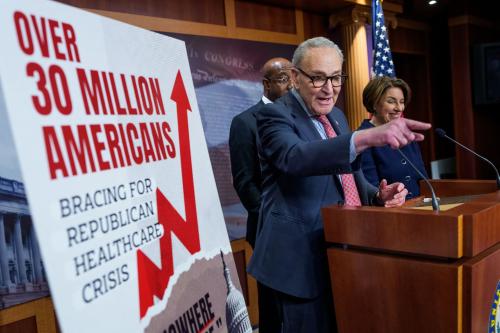Executive summary
The Social Services Block Grant (SSBG) may be eliminated in the reconciliation process. This issue brief describes the block grant, its history and funding levels, and how those funds are used by states. On many occasions, Republicans have endorsed block grant funding as the ideal funding structure to provide monies to states.
The SSBG, also known by many as Title XX (Title Twenty), is a federal financing structure that directs funding to states and local governments to help support a variety of social services serving low-income children and older adults. The SSBG has been through numerous legislative changes since the 1950s, going from an entitlement to a block grant. The two most notable features of this block grant are: flexibility, directing states to govern their programs; and its fixed annual funding levels, which are not adjusted for inflation. If SSBG federal funding is eliminated or substantially reduced, it is unlikely that states will increase their own funding levels for the programs that the grant currently supports. Consequently, low-income families will bear the brunt of funding reductions.
The SSBG has already been drastically cut in funding as well, slashed from its highest level of nearly $3 billion in 1979 to $1.7 billion in 2025, a cut of about 43%.1 If adjusted for inflation and child and elderly poverty, there has been an 89% reduction.2
While SSBG funding has decreased over the last 70 years, the critical need for these services and funding within states remains. SSBG funding covers programs that support eight high-level service areas (HSLAs): child welfare, self-sufficiency, counseling and support, special services for disabled individuals, daycare for children, vulnerable and elderly adults (including home-delivered meals, known as “Meals on Wheels”), health services, and additional housing, legal, and prevention services.3 The total SSBG expenditures of $2.66 billion in 2022 served about 20 million individuals, representing 9.2 million children and 11 million adults.4 The SSBG is critical in funding child welfare infrastructure and represents on average 10% of federal child welfare funding through child protective services and foster care, and constitutes even larger portions of child welfare funds in specific states.5 Older adults receive another significant portion of SSBG funding, with $237 million allocated to supporting older adults through adult daycare and other services intended to prevent extensive and expensive hospitalization and nursing home visits.6
This brief explores the historical and current impact of legislative and budgetary decisions on the SSBG and why proposed cuts could be harmful to low-income families and the valuable services that the SSBG provides.
A block grant is a fixed amount of funding that is given to states by the federal government based on the state’s population. The Social Services Block Grant (SSBG) is a block grant that combines federal funding for a variety of social services and programs and allocates funds to states for the broad purpose of social welfare. For the SSBG, the pre-set amount of funding doesn’t change based on inflation or recipient caseload.
The SSBG is a critical source of funding for a wide range of social welfare and social service programs across many states, and states manage what programs and services to fund with minimal federal oversight. Historically, SSBG has been a bipartisan-supported grant given its fixed funding and state flexibility.
The broad outlined goals of SSBG are:7
- Achieving and maintaining economic and social self-sufficiency;
- Preventing or remedying neglect, abuse, or exploitation of children and adults who are unable to protect their own interests; and preserving or rehabilitating families;
- Preventing or reducing inappropriate institutional care by providing community-based or home-based care services; and,
- Securing referral or admission for institutional care, when needed.
These goals have generally oriented states to use SSBG funding to address child welfare services, along with services for older adults and individuals with disabilities, and intimate partner violence or domestic violence services. SSBG supports over 29 different human service programs across states.8 More specifically, SSBG funds have supported access to childcare, foster care, substance use disorder treatment, home-delivered meals, and more.9 However, the format of the block grant ultimately gives states significant authority in deciding what social services within the eight high-level service areas (HLSAs) to address and prioritize, and who should deliver and receive such services.10 The SSBG often provides services for low-income families and individuals, but states ultimately are given discretion over implementing eligibility criteria for SSBG-funded services.11 The SSBG not only addresses critical social service funding needs but also serves to fill in state budget gaps for human services where necessary.12
SSBG has provided critical services for 70 years
The Social Security Act
The SSBG can be traced back to the Social Security Amendments of 1956, which were passed under Republican President Eisenhower and a Democratic-controlled Congress, where federal funding was first authorized for social services.13 From 1956 to 196714, federal funding for social services went through many amendments, which expanded social services funding and scope from child welfare to public assistance recipients, included funding for job training and childcare15, and increased the federal matching rate for state social service expenditures to 75% to introduce incentives for states to finance and support services aimed at reducing poverty and prioritizing social welfare.16 As states began to utilize the matching federal dollars, federal spending on social services increased from $281.6 million in fiscal year (FY) 1967 to $1.7 billion in FY 1972.17 In 1972, Congress introduced new limitations on state spending for social services, requiring most state funding be distributed to individuals currently receiving cash assistance rather than former or potential recipients as previously allowed, and placing a $2.5 billion funding ceiling.18
Title XX
In 1975, President Ford signed legislation that created the Title XX program to consolidate these various social service programs and their funding into one grant. The Title XX program was a capped entitlement program, meaning individuals have a right to benefits if they qualify, but federal funding is capped. Title XX allocated the previously established $2.5 billion ceiling19 in federal funding to states, based on population, for a defined range of social services such as preventing child abuse, availability of child care, and community-based care for the elderly and disabled populations.20 While the goal was to maintain flexibility and state discretion regarding funding and services provided, the federal government still outlined certain planning requirements and eligibility standards, and retained the 75% matching rate.21
Social Services Block Grant
Under the Reagan administration, alongside discussions of cutting taxes and reducing the federal budget deficit, Title XX and other categorical grants were reexamined as part of an effort to increase state flexibility and reduce the burden of federal oversight.22 In 1981, to give states more control over their social service spending, the SSBG was officially established by the Omnibus Budget Reconciliation Act (OBRA), replacing the Title XX entitlement program with a flexible block grant for states, which removed individual entitlement to benefits while retaining a fixed funding status and increasing state authority.23
Funding was initially set at $2.4 billion annually in FY 1982, with the intention of rising to $2.7 billion by FY 1986.24 The $2.4 billion cap was below the Congressional Budget Office’s projections of a FY 1981 total need of $3.1 billion for the program.25 The SSBG was purposefully defined as a block grant, to allow for states to use funds to achieve a wide range of social policy goals26 including promotion of self-sufficiency, child abuse prevention, and community-based care for older adults and people with disabilities. Guided by these broad goals, the SSBG no longer had matching requirements, federally-outlined eligibility requirements such as income requirements (although states were able to set their own criteria and restrictions27), or required funding allocations to certain services.28
SSBG funding has already been cut substantially
How much has been historically cut by legislation?
From the initial funding ceiling set at $2.5 billion in 1972, the SSBG increased to $2.99 billion in 1979 and ranged from 2.99 billion to $2.4 billion between 1979 and 1996.29 The SSBG experienced further legislative budget reductions throughout the 1990s and 2000s. In 1996, the Clinton administration signed into law the Personal Responsibility and Work Opportunity Reconciliation Act (PRWORA) which further redistributed and reduced funding.30 The PRWORA created the Temporary Assistance for Needy Families (TANF) block grant which focused on providing cash assistance to low-income families with work requirements, and also redirecting SSBG childcare funds to the Child Care and Development Block Grant.31 The new block grants reduced the funding of SSBG to $2.38 billion for fiscal years 1997 through 2002, with the intention to return to $2.8 billion in 2003.32 Despite efforts to restore funding by 2003, the Transportation Equity Act passed in 1988 further reduced funding for the SSBG to $1.7 billion, where the cap has remained.33
How has SSBG funding been impacted, adjusting for inflation and child poverty?
The SSBG was at its highest cap in 1979, at $2.991 billion, and it has now fallen to $1.7 billion. The SSBG funding today has been reduced by about $1.291 billion, or 43%, without adjusting for inflation. After adjusting for inflation and child and elderly poverty levels from 1979 to 2023, SSBG funding has been cut by an estimated 89%.34 Today, the annual budget for the SSBG remains at $1.7 billion, but if the block grant was an open-ended entitlement program and financing kept up with inflation and child and elderly poverty, the funding level should be at least $13.9 billion.35
Repeal efforts and bipartisan responses
In recent years, numerous proposals in Congress have called for completely repealing or further scaling back SSBG funding, which have been fought against with bipartisan support. In 2000, a bipartisan group of Senators and Representatives, spearheaded by Senator Bob Graham (D-FL) and Representatives Nancy Johnson (R-CT) and Sander Levin (D-MI), introduced bills in both the House and Senate aimed at restoring SSBG funding to $2.38 billion, the level authorized before the Transportation Equity Act.36 From FY 2007 to FY 2009, President Bush proposed a cut of 30% in SSBG funding in the budget resolution, which was rejected by Senator Chuck Grassley (R-IA) in budget committee hearings.37 While funding was not successfully restored at this time, funding wasn’t fully eliminated either.
From 2012 to 2014, House and Senate Republicans introduced many bills aimed at cutting SSBG funding entirely. One attempt was made through a House Reconciliation bill that permanently eliminated the SSBG, but despite House approval, the Senate did not pass the bill, and the official funding cap of SSBG was kept at $1.7 billion.38 The Senate and House both had additional bills introduced targeting the entire elimination of the SSBG funds, but ultimately continued to fund SSBG.39 However, SSBG appropriations became subject to sequestration in FY 2013 due to the Budget Control Act of 2011, a spending reduction process, which did approximately reduce SSBG funding by $86 million.40
In more recent years, under the first and current Trump administration, the proposal to eliminate the SSBG has resurfaced, especially among Congressional Republicans.41
Ironically, Republicans are now planning to eliminate a form of funding they once strongly backed
As outlined previously, each historical iteration of the SSBG, besides PRWORA under President Clinton, was executed under Republican administrations and Democratic-controlled Congresses. Even with cuts and federal deficit concerns, block grant funding has historically been seen as a highly favorable solution among bipartisan leadership for many reasons.
For one, block grants with relatively stable (or relatively growing) funding can promote federal savings.42 SSBG funding levels are determined by Congress and are not required to be frequently adjusted for inflation. Due to this financing structure, the federal savings of a fixed block grant can be compared with its inflation-adjusted counterpart. If the current $1.7 billion SSBG funding level had been $13.9 billion today (adjusting for inflation and child and elderly poverty), that could mean over $12 billion in savings. Some even suggest increasing state incentives to contribute to benefit costs could create additional savings.43
Secondly, block grant funding is highly dependent on state flexibility and state policymaking decisions. Each state has different service needs, population demographics, and budgets44, and can respond to their own local challenges accordingly. With flexible yet capped grant funding, states can decide how they want to spend that fixed money and what services and populations should be prioritized through benefit eligibility decisions. It also relies on more state fiscal responsibility in designing social programs and arranging other sources of state funding to foster such social welfare improvements.45
How SSBG funds are spent today: A state-by-state overview
To understand the impact of the proposals to eliminate the SSBG, there is a need to understand the funding structure and the importance of the SSBG financing system currently.
The current funding for the SSBG has been at an annual $1.7 billion since the early 2000s, which is already low, accounting for child and elderly poverty and inflation, and is facing threats of complete elimination. Even with fixed funding, the SSBG supports a range of demographics and social services considerably. In FY 2022, states reported over 20 million individuals receiving SSBG-funded services, representing 9.2 million children and 11 million adults (See Table 1).46 Additionally, 44 states allocated $208 million towards services for one million older adults in need.47 Over 20 million individuals could be at risk of losing key social services addressing and preventing poverty and child and elder abuse. Furthermore, cutting the SSBG introduces unemployment risks to increasingly necessary social service providers, such as childcare providers, child protective service workers, and home health aides.48
Table 1 shows how much funding would be lost if the SSBG were to be eliminated and how many recipients could lose access to vital services at the state level. For example, California, which received major funding based on population in FY 2022, could lose something like $191 million in social welfare funding, impacting nearly 1.7 million recipients, 1.4 million of whom are children.49
State and local governments rely on SSBG funding to cover eight key service areas: child welfare, self-sufficiency, counseling and support, special services for disabled individuals, daycare for children, vulnerable and elderly adults, health and wellbeing, and additional support services.50 Of these key areas, SSBG funding highly impacts recipients receiving services such as counseling, child welfare or youth at risk, and daycare services (See Figure 1).51 Additionally, SSBG’s top spending areas are child welfare or youth at risk, additional support services, and counseling and support, which are also likely areas of critical budget shortfalls for states that might not be funded without SSBG (See Figure 2).52 Overall, SSBG funds represent 10% of total annual federal child welfare spending, and even larger proportions of specific state child welfare funds in Hawaii, West Virginia, Oklahoma, Michigan, and Louisiana.53
Additionally, about 2.4 million children’s daycare services are funded by SSBG, putting many families at risk of losing their access to child care and early education supports, especially when child care is already underfunded in many states.54 SSBG funding also accounts for 99% of total SSBG and TANF transfer expenditures on vulnerable and elderly adults, which is about $236 million in older adults served by SSBG-specific funding (See Figure 2).55
Conclusion
Since the 1970s, the SSBG funding has undergone several legislative changes with major funding cuts, both nominally and adjusted for inflation and child and elderly poverty. From 1979 to 2023, SSBG funding has been cut by an estimated 89%, adjusting for inflation and child and elderly poverty levels. Yet it still provides critical funding for child welfare, older adults, and disability services. Its elimination would be felt by many low-income families. Although the preferred funding level is open to question, the block grant structure has historically been strongly defended by both Democrats and Republicans as a way of financing social services. If this block grant is eliminated or funding is substantially reduced, low-income families will bear the burden as states are unlikely to increase funding levels for these social services in the absence of federal support.
-
Acknowledgements and disclosures
The authors thank Lauren Bauer for comments on an earlier draft and Chloe Zilkha for excellent research assistance. They also thank Morna Miller, Rebecca Robuck, Stacy Sanders for initial guidance on the brief.
-
Footnotes
- Committee on Ways and Means, U.S. House of Representatives. 1996. 1996 Green Book: Background Material and Data on Programs within the Jurisdiction of the Committee on Ways and Means (104th Congress, Committee Print 104-14, Section 11). U.S. Government Printing Office; Lynch, Karen E. 2024. “Social Services Block Grant.” IF10115. Congressional Research Service. https://www.congress.gov/crs_external_products/IF/PDF/IF10115/IF10115.8.pdf; See more details on the author’s calculations in footnote 34.
- Author’s calculation and see footnote 34 for details; the calculations are adjusting for inflation and scaling for the number of children and older adults in poverty.
- Office of Community Services, Administration for Children & Families. 2024. “Social Service Block Grant: Fiscal Year 2022 Annual Report.” U.S. Department of Health & Human Services. https://acf.gov/sites/default/files/documents/ocs/RPT_SSBG_FY-2022-Annual-Report_Final_508.pdf.
- Ibid. Total SSBG expenditures include both SSBG funding, which the issue brief focuses on, and some Temporary Assistance for Needy Families (TANF) transfer funds, which states can choose to transfer up to 10% from TANF and allocate toward programs typically covered by SSBG funding. That is why SSBG expenditures can be above the $1.7 billion cap authorized.
- Child Welfare League of America (CWLA). 2025. “Hot Topic: Protect Child Welfare Funding in Reconciliation.” https://www.cwla.org/wp-content/uploads/2025/04/2025_HT_SSBG_e.pdf.
- Office of Community Services, 2024.
- Committee on Ways and Means, 1996.
- CWLA, 2025.
- Office of Community Services. 2025. “SSBG Fact Sheet.” U.S. Department of Health & Human Services. Accessed April 23. https://acf.gov/ocs/fact-sheet/ssbg-fact-sheet.
- CWLA. 2017. “Maintain the Social Services Block Grant.” https://www.cwla.org/wp-content/uploads/2017/03/Maintain-the-Social-Services-Block-Grant-17.pdf; Primus, Wendell, and Kristina Daugirdas. 2000. “Senate Appropriations Bill Contains Severe Reductions in Social Services Block Grant. Program Funds Services for Vulnerable Low-Income Children and People Who Are Elderly or Disabled.” Center on Budget and Policy Priorities. https://www.cbpp.org/sites/default/files/archive/6-8-00wel.htm.
- Committee on Ways and Means, 1996.
- CWLA, 2025.
- Lynch, Karen E., 2024; U.S. Congress. 1956. “Social Security Amendments of 1956.” Public Law 84-880. 70 Stat. 807.
- Public Welfare Amendments of 1962; Social Security Amendments of 1967.
- Committee on Ways and Means, U.S. House of Representatives. 1998. Title XX Social Services Block Grant Program. In 1998 Green Book: Background Material and Data on Programs Within the Jurisdiction of the Committee on Ways and Means (105th Congress, Committee Print 105-7, Section 10). U.S. Government Printing Office. https://www.govinfo.gov/content/pkg/GPO-CPRT-105WPRT37945/pdf/GPO-CPRT-105WPRT37945-2-10.pdf.
- CWLA, 2017.
- Committee on Ways and Means, 1998.
- Ibid.
- Ibid.
- Illinois Department of Human Services. n.d. “Title XX Social Service Reports.” IDHS. https://www.dhs.state.il.us/page.aspx?item=31680.
- Committee on Ways and Means, 1998; CWLA, 2017.
- CWLA, 2017; Schmit, Stephanie, and Rachel Wilensky. 2025. “Cuts to SSBG, TANF Would Eliminate Child Care for 40K Children, Disrupt Care for Millions More.” The Center for Law and Social Policy. https://www.clasp.org/wp-content/uploads/2025/03/2025.3.5_Cuts-to-SSBG-TANF-Would-Eliminate-Child-Care.pdf.
- U.S. Congress. 1981. “Omnibus Budget Reconciliation Act of 1981.” Public Law 97-35. 95 Stat. 357; Committee on Ways and Means, 1998; CWLA, 2025.
- Committee on Ways and Means, 1998.
- CWLA, 2017.
- Lynch, Karen E. 2016. “Social Services Block Grant: Background and Funding.” 94–953. Congressional Research Service. https://sgp.fas.org/crs/misc/94-953.pdf.
- Ibid.
- CWLA, 2017.
- Committee on Ways and Means, 1998.
- Committee on Ways and Means, 1996.
- Committee on Ways and Means. 1996. “[1996 Green Book] Appendix L. Summary of Welfare Reforms Made by Public Law 104-193, the Personal Responsibility and Work Opportunity Reconciliation Act and Associated Legislation.” https://aspe.hhs.gov/sites/default/files/private/aspe-files/210906/lappend.txt.
- Primus, Wendell, and Kristina Daugirdas, 2000.
- Primus, Wendell, and Kristina Daugirdas, 2000; CWLA, 2017; Schmit, Stephanie, and Rachel Wilensky 2025.
- Authors’ calculations, using 2023 numbers. SSBG funding was $1.7B in 2023. 89% is found by adjusting the $2.991B number by inflation, and poverty among children and older adults. The inflation multiplier is found using the CPI in March 1979 and March 2023: Inflation multiplier = (2023 CPI)/(1979 CPI) = 301.836/69.8 = 4.324. The child and elderly poverty multiplier is found using CPS data on the number of children living below the poverty line in 1979 and 2023 and the number of adults 65 years and older living below the poverty line in 1979 and 2023: Child and elderly poverty multiplier = (number of children + number of adults 65 and older in poverty in 2023)/(number of children + number of adults 65 and older in poverty in 1979) = 16.468M/13.675M = 1.204. The final equation for an inflation, child poverty, and elderly poverty-adjusted budget number is: (SSBG funding in 1979)(inflation multiplier)(child and elderly poverty multiplier) = ($2.991B)(4.324)(1.204) = $15.57B. The shortfall between $15.57B and $1.7B is $13.87B, or 89%.
- Authors calculations. See footnote 34 for more details.
- U.S. Congress. 2000. “Social Services Block Grant Amendments of 2000.” Senate Bill 2585, 106th Congress. https://www.congress.gov/bill/106th-congress/senate-bill/2585/cosponsors?s=2&r=2&q=%7B%22search%22%3A%22social+services+service+block+grant%22%7D; U.S. Congress. 2001. “Social Services Block Grant Amendments of 2001.” House Bill 1470, 107th Congress. https://www.congress.gov/bill/107th-congress/house-bill/1470/cosponsors?s=4&r=3&q=%7B%22search%22%3A%22social+services+service+block+grant%22%7D.
- CWLA, 2017.
- Congressional Budget Office. 2012. “Repeal of the Program of Block Grants to States for Social Services.” https://www.cbo.gov/sites/default/files/112th-congress-2011-2012/costestimate/ssbgrepeal0.pdf.
- U.S. House of Representatives. 2012. Sequester Replacement Reconciliation Act of 2012. H.R. 5652, 112th Cong., 2nd sess., May 9, 2012. https://www.govinfo.gov/content/pkg/BILLS-112hr5652eh/pdf/BILLS-112hr5652eh.pdf; U.S. Senate. A bill improving outcomes for youth at risk for sex trafficking, and other purposes, S. 1518, 113th Cong., 1st sess., September 18, 2013. https://www.congress.gov/bill/113th-congress/senate-bill/1518/text#toc-id7E8D7EEB7099400E974802601C4202DF.
- Schmit, Stephanie, and Rachel Wilensky, 2025; CWLA, 2017.
- Pavetti, Ladonna, and Ife Floyd. 2016. “Eliminating Social Services Block Grant Would Weaken Services for Vulnerable Children, Adults, and Disabled.” Center on Budget and Policy Priorities. https://www.cbpp.org/research/eliminating-social-services-block-grant-would-weaken-services-for-vulnerable-children.
- Weidinger, Matt, and Angela Rachidi. 2025. “In Case of Emergency, Open Block Grant: Part 1.” COSM Commentary (blog). April 23, 2025. https://cosm.aei.org/in-case-of-emergency-open-block-grant-part-1/?mkt_tok=NDc1LVBCUS05NzEAAAGaC14YUAHpf0nmWbsFkXcPvGx-HkqkicT8Euvuv1-W-axEmEuEQPhhw_lspJAO5EvSrwwTxzk1Xumm6t2jsw4X70OQjbQOHlI20LNmttIad9BzwUXobQ; Weidinger, Matt, and Angela Rachidi. 2025. “In Case of Emergency, Open Block Grant: Part 2.” COSM Commentary (blog). April 23, 2025. cosm.aei.org/in-case-of-emergency-open-block-grant-part-2/.
- Rachidi, Angela, Matt Weidinger, and Scott Winship. 2022. “A Safety Net for the Future: Overcoming the Root Causes of Poverty.” In American Renewal: A Conservative Plan to Strengthen the Social Contract and Save the Country’s Finances. American Enterprise Institute. https://www.americanrenewalbook.com/a-safety-net-for-the-future-overcoming-the-root-causes-of-poverty/.
- More on specific states and SSBG funding can be found here: Office of Community Services, Administration for Children & Families. 2024. “Social Service Block Grant: Fiscal Year 2022 Annual Report.” U.S. Department of Health & Human Services. https://acf.gov/sites/default/files/documents/ocs/RPT_SSBG_FY-2022-Annual-Report_Final_508.pdf.
- Weidinger, Matt, and Angela Rachidi. “In Case of Emergency, Open Block Grant: Part 2.” 2025.
- Office of Community Services, 2024.
- Office of Community Services, 2025.
- Schmit, Stephanie, and Rachel Wilensky, 2025; U.S. Senate Committee on Health, Education, Labor, & Pensions, and U.S Senate Committee on Agriculture, Nutrition, & Forestry. n.d. “War on Kids: How Republican Cuts Hurt Children.” U.S. Senate Committee on Finance. https://www.finance.senate.gov/imo/media/doc/r_war_on_kids.pdf.
- Administration for Children and Families. n.d. SSBGPortal Data Dashboard. Department of Health and Human Services. Accessed May 6, 2025. https://ssbgportal.acf.hhs.gov/DataDash.
- Office of Community Services, 2024.
- Ibid.
- Ibid.
- Office of Community Services, 2024; CWLA, 2025.
- Office of Community Services, 2024.
- Ibid.
The Brookings Institution is committed to quality, independence, and impact.
We are supported by a diverse array of funders. In line with our values and policies, each Brookings publication represents the sole views of its author(s).





